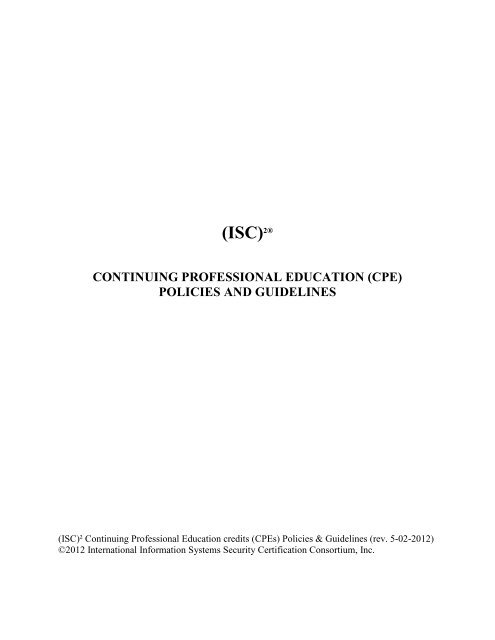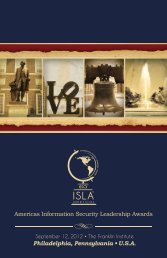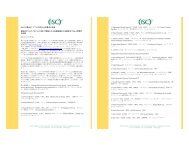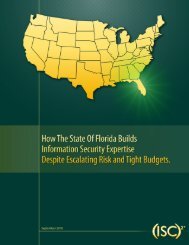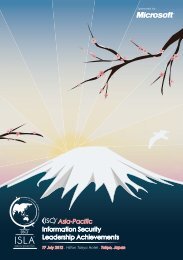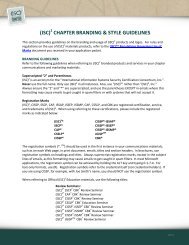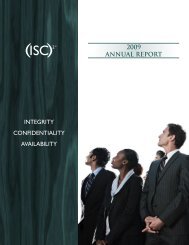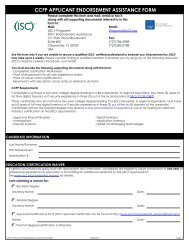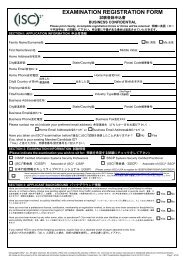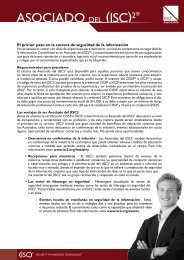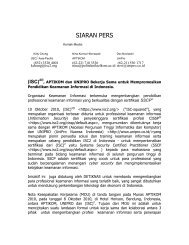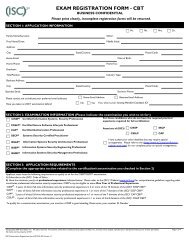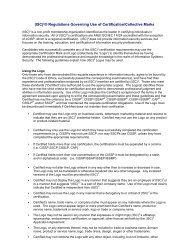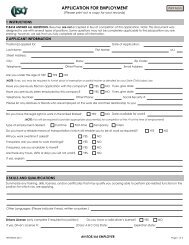CPE Policies and Guidelines - ISC
CPE Policies and Guidelines - ISC
CPE Policies and Guidelines - ISC
Create successful ePaper yourself
Turn your PDF publications into a flip-book with our unique Google optimized e-Paper software.
(<strong>ISC</strong>) 2®<br />
CONTINUING PROFESSIONAL EDUCATION (<strong>CPE</strong>)<br />
POLICIES AND GUIDELINES<br />
(<strong>ISC</strong>)² Continuing Professional Education credits (<strong>CPE</strong>s) <strong>Policies</strong> & <strong>Guidelines</strong> (rev. 5-02-2012)<br />
©2012 International Information Systems Security Certification Consortium, Inc.
Table of Contents<br />
Overview ....................................................................................................................................................... 2<br />
Continuing Professional Education Credit (<strong>CPE</strong>) General Requirements ..................................................... 2<br />
Required Number of <strong>CPE</strong> Credits .................................................................................................................. 3<br />
Concentrations .......................................................................................................................................... 4<br />
Multiple Credentials .................................................................................................................................. 4<br />
Rollover <strong>CPE</strong> .............................................................................................................................................. 5<br />
Failure to Meet Requirements .................................................................................................................. 5<br />
Continuing Professional Education (<strong>CPE</strong>) Activities ...................................................................................... 6<br />
Group A <strong>and</strong> Group B <strong>CPE</strong> Credits ............................................................................................................. 6<br />
Group A <strong>and</strong> Group B Credits Shown by Credential ................................................................................. 7<br />
Calculating <strong>CPE</strong> Credits ............................................................................................................................. 8<br />
Approved <strong>CPE</strong> Credit Submitters ............................................................................................................ 14<br />
Record Keeping <strong>and</strong> Auditing of Continuing Professional Education (<strong>CPE</strong>) credit Hours ....................... 14<br />
Record Keeping ....................................................................................................................................... 15<br />
Appeal Process: ....................................................................................................................................... 15<br />
Appendix A .................................................................................................................................................. 16<br />
Domain Credit Compatibility Matrix ........................................................................................................... 16<br />
1
Overview<br />
Achieving a certification represents a significant milestone in a (<strong>ISC</strong>) 2® member’s career. To<br />
help ensure that members remain competitive <strong>and</strong> keep up with the constantly exp<strong>and</strong>ing body of<br />
knowledge in their field, it is important for them to continue their professional development. By<br />
growing <strong>and</strong> enhancing their skills through Continuing Professional Education (<strong>CPE</strong>) activities,<br />
members are making an important investment in themselves <strong>and</strong> their career - increasing value to<br />
their customers <strong>and</strong> employers.<br />
This <strong>CPE</strong> <strong>Guidelines</strong> document describes the <strong>CPE</strong> requirements <strong>and</strong> activities necessary during<br />
each year of a member’s three-year certification cycle. The <strong>CPE</strong> requirements ensure that<br />
members maintain their (<strong>ISC</strong>) 2 certifications.<br />
These guidelines give our members an overview of a variety of activities which count for <strong>CPE</strong><br />
credits. Members may use these guidelines to help calculate their <strong>CPE</strong> credits. Please keep in<br />
mind these are guidelines only. As professionals who subscribe to the (<strong>ISC</strong>) 2 Code of Ethics,<br />
members should use their best judgment when using these guidelines to select those activities<br />
which qualify for <strong>CPE</strong> credits <strong>and</strong> which will enhance their professional development. It is<br />
important that members should underst<strong>and</strong>, in most instances, they cannot earn <strong>CPE</strong> credits for<br />
work they do in the regular day-to-day performance of their jobs. However, members may earn<br />
<strong>CPE</strong> credits for engaging in unique projects <strong>and</strong> activities in their workplace which are outside of<br />
their normal job functions that require them to exp<strong>and</strong> their knowledge base <strong>and</strong>/or skill set.<br />
(<strong>ISC</strong>) 2 strives to make earning <strong>CPE</strong> credits as simple as possible for its members so that they do<br />
not consider obtaining <strong>CPE</strong>s as a burden but an opportunity to grow within their chosen<br />
profession of IT security. Members can earn <strong>CPE</strong> credits for a variety of educational<br />
opportunities, many of which are inexpensive or at no cost. They should regularly visit (<strong>ISC</strong>) 2<br />
website for exploring available opportunities for earning <strong>CPE</strong>s.<br />
Continuing Professional Education Credit (<strong>CPE</strong>) General Requirements<br />
To maintain their certifications, members are required to earn <strong>and</strong> submit a minimum number of<br />
<strong>CPE</strong> credits during each of their three-year certification cycle, including a minimum number of<br />
<strong>CPE</strong>s that must be earned annually during each year of their three-year cycle. The total number<br />
of <strong>CPE</strong> credits earned each year of the three-year cycle must add up to the minimum <strong>CPE</strong> credits<br />
required during a three-year certification cycle.<br />
<strong>CPE</strong> credits are categorized as either Group A credits or Group B credits, depending on how<br />
the associated activities relate to the domains of each certification. Group A credits are for direct<br />
domain-related activities. Group B credits are for activities that are outside of the domain, yet<br />
enhance a member’s general professional skills <strong>and</strong> competencies.<br />
2
All <strong>CPE</strong> activities must be completed or earned during the three years of each certification cycle<br />
<strong>and</strong> no later than the certification expiration date (the end of member’s certification cycle).<br />
Following the certification expiration date, members are allowed a 90-day grace period to<br />
complete the submission of all <strong>CPE</strong> credits, but the credits must be earned by the expiration date.<br />
It is in the members’ best interest to submit all of their required <strong>CPE</strong> credits as soon as possible.<br />
At the end of the three-year certification cycle, when both required <strong>CPE</strong> credits <strong>and</strong> Annual<br />
Maintenance Fee (AMF) payment requirements are met, members’ renewal to a new three-year<br />
certification cycle will be processed. Members will receive a renewal package via postal mail,<br />
which includes a new certificate <strong>and</strong> their ID card.<br />
Required Number of <strong>CPE</strong> Credits<br />
The minimum number of <strong>CPE</strong>s required each year <strong>and</strong> during a three-year certification cycle is<br />
determined by the type of certification or designation members hold. See Table 1 below for<br />
detailed requirements to full credential holders, <strong>and</strong> Table 2 for Associate of (<strong>ISC</strong>) 2 designees.<br />
Table 1: <strong>CPE</strong> Requirements for Full Credential Holders<br />
Credential<br />
<strong>CPE</strong> CERTIFICATION REQUIREMENTS<br />
Annual Minimum<br />
(Required)<br />
Group A - Only<br />
Group A (Minimum<br />
for 3 Year<br />
Certification Period)<br />
3<br />
3 Year Certification Period<br />
Group B<br />
Optional<br />
CSSLP 15 60 30 90<br />
CISSP 20 80 40 120<br />
ISSAP<br />
ISSEP<br />
ISSMP<br />
ISSJP<br />
Total Required<br />
(For 3 Year Certification<br />
Period)<br />
For these concentration certifications, 20 of the 120 <strong>CPE</strong>s already required for the<br />
underlying CISSP certificate must be in the specific area of concentration during a<br />
member’s subsequent 3-year certification period. For example, if a CISSP took<br />
the ISSEP concentration examination <strong>and</strong> passed, he/she should submit at least<br />
20 of the total 120 hours required for the CISSP certificate to be specific to the<br />
engineering (or ISSEP) concentration.<br />
CAP 10 40 20 60<br />
SSCP 10 40 20 60
Table 2: <strong>CPE</strong> Requirements for Associate of (<strong>ISC</strong>) 2 Designee<br />
Concentrations<br />
If a member holds a CISSP concentration, 20 hours credit per year of the 120 credits in a threeyear<br />
cycle required for the CISSP must be directly related to his/her concentration. If a member<br />
holds more than one concentration, he/she must earn 20 credits per year in each area of the<br />
concentration. <strong>CPE</strong>s required for a concentration are automatically counted toward the CISSP<br />
<strong>CPE</strong> requirement.<br />
For example, if a member holds an ISSAP <strong>and</strong> ISSMP, he/she must earn 20 credits related to the<br />
ISSAP domains <strong>and</strong> 20 credits toward the ISSMP domains. These 40 credits will automatically<br />
apply to the 120 credits required to renew his/ her CISSP.<br />
Multiple Credentials<br />
<strong>CPE</strong> REQUIREMENTS<br />
Associate of (<strong>ISC</strong>) 2 Designation Group A Total Hours/Year<br />
Associate of (<strong>ISC</strong>)² working toward CISSP* 20 20<br />
Associate of (<strong>ISC</strong>)² working toward SSCP* 10 10<br />
Associate of (<strong>ISC</strong>)² working toward CSSLP* 15 15<br />
Associate of (<strong>ISC</strong>)² working toward CAP* 10 10<br />
If a member holds more than one (<strong>ISC</strong>)² credential, the <strong>CPE</strong>s he/she submits will automatically<br />
be counted toward all of his/ her active credentials. Members should not enter <strong>CPE</strong> activities in<br />
their record (member database) more than one time.<br />
If the domain a member selects for his/ her submission corresponds to a domain of one of his/<br />
her additional credentials, the <strong>CPE</strong> credits will be considered Group A credits for each<br />
credential.<br />
If the additional credential does not have a corresponding domain, the credits will be considered<br />
Group B for the additional credential.<br />
4
For example, if a member submits <strong>CPE</strong> credits with the CISSP domain– Software Security, the<br />
<strong>CPE</strong> will count as a Group A credit for the CISSP as well as for the CSSLP because the CISSP<br />
domain corresponds to the CSSLP domain – Software Acceptance. However, this <strong>CPE</strong> credit<br />
will count as a Group B credit for the CAP because there is no corresponding domain for the<br />
CAP.<br />
Please see Appendix “A” - Domain Credit Compatibility Matrix - for a complete list of<br />
corresponding domains.<br />
Rollover <strong>CPE</strong><br />
If a member submits more than the required minimum of Group A (domain-related) credits every<br />
year, he/she would end up with more <strong>CPE</strong> credits than is necessary within the three-year cycle.<br />
For example, for CISSP, only 20 <strong>CPE</strong> credits per year of Group A <strong>CPE</strong>s are required. However,<br />
if a member submits 40 <strong>CPE</strong> credits of Group A <strong>CPE</strong> credits every year for three years, totaling<br />
120 Group A <strong>CPE</strong> credits in the cycle, not all extra <strong>CPE</strong> credits submitted can be rolled over to<br />
the next cycle. Only the additional credits earned during the final six months of the three-year<br />
certification cycle can be rolled over as excess Group A credits to member’s base credential <strong>and</strong><br />
applied to member’s next three-year cycle. These rollover credits are calculated at the time of<br />
member’s renewal processing.<br />
*Note that there is no rollover provision for Group B credits.<br />
*Note that rollover <strong>CPE</strong>s do not count toward annual <strong>CPE</strong> requirements. They will only<br />
count towards the total <strong>CPE</strong> requirement required during a 3-year cycle.<br />
Failure to Meet Requirements<br />
Failure to meet the minimum annual <strong>CPE</strong> credit <strong>and</strong> the AMF requirements will result in<br />
suspension of a member’s certification, which is the loss of right of certification for the period<br />
of the suspension. Once the suspension is in effect, a member’s “good st<strong>and</strong>ing” rights are<br />
immediately revoked. Access to the (<strong>ISC</strong>) 2 Member Website will be restricted to entering only<br />
<strong>CPE</strong> credits, <strong>and</strong>/or paying AMFs.<br />
Suspension of certification can only be lifted when the minimum annual <strong>CPE</strong> credit <strong>and</strong> AMF<br />
requirements are met. From the date of suspension, members have a 90-day grace period to get<br />
their previously earned <strong>CPE</strong> credits <strong>and</strong> AMFs up to date. Actions resulting in suspension in the<br />
last year of members’ certification cycle will result in decertification at the end of the 90 day<br />
grace period following the certification expiration date. (<strong>ISC</strong>) 2 will send a notification by email to<br />
inform the member that he/she has been decertified.<br />
5
Continuing Professional Education (<strong>CPE</strong>) Activities<br />
<strong>CPE</strong> credits are earned for participating in activities where members gain knowledge from the<br />
experience. Typically, education qualifying for <strong>CPE</strong> credits will be gained outside of the<br />
workplace. If work is done as part of one’s normal job, that work activity will not qualify for<br />
<strong>CPE</strong> credits. However, members can earn <strong>CPE</strong> credits for activities performed during members’<br />
regular working hours when they are engaged in unique projects, assignments or activities - more<br />
on the unique projects are provided under the “Calculating <strong>CPE</strong> Credits” heading below.<br />
Group A <strong>and</strong> Group B <strong>CPE</strong> Credits<br />
• Group A Credits: Domain-Related Activities. Group A credits relate directly to<br />
activities in the areas covered by the specific domains of the respective credential.<br />
• Group B Credits: Professional Development/Knowledge Sharing. Group B credits<br />
are earned for completion of general professional development activities which enhance<br />
a member’s overall professional skills, education, knowledge, or competency outside of<br />
the domains associated with the respective credentials . These generally include<br />
professional development programs, such as professional speaking or management<br />
courses. While these do not apply directly to the domains, (<strong>ISC</strong>) 2 recognizes these skills<br />
are vital in the professional growth of all credentials holders.<br />
In the next page, specific topics, content or areas for earning Group A <strong>and</strong> Group B credits are<br />
shown for each credential.<br />
6
Group A <strong>and</strong> Group B Credits Shown by Credential<br />
CAP ® ________________________________________________________________________<br />
Group A Credits: Direct CAP Domain-Related<br />
Activities<br />
• Underst<strong>and</strong> the Security Authorization of<br />
Information Systems<br />
• Categorize Information Systems<br />
• Establish the Security Control Baseline<br />
• Apply Security Controls<br />
• Assess Security Controls<br />
• Authorize Information System<br />
• Monitor Security Controls<br />
7<br />
Group B Credits: Suggested Categories of<br />
General Professional Development Activities<br />
• Management courses<br />
• Interpersonal communications skills<br />
• Interviewing techniques<br />
• Team development skills<br />
• Project planning activities<br />
• Technical skills not in information security<br />
– such as programming languages <strong>and</strong><br />
techniques<br />
• Accounting Courses<br />
CISSP ® _____________________________________________________________________<br />
Group A Credits: Direct Information Security<br />
Domains of the (<strong>ISC</strong>) 2 CBK<br />
• Access Control<br />
• Telecommunications & Network Security<br />
• Information Security Governance & Risk<br />
Management<br />
• Software Development Security<br />
• Cryptography<br />
• Security Architecture & Design<br />
• Operations Security<br />
• Business Continuity & Disaster Recovery<br />
Planning<br />
• Legal, Regulations, Investigations <strong>and</strong><br />
Compliance<br />
• Physical (Environmental) Security<br />
CSSLP CM __________________________________________________________________________<br />
Group A Credits: Direct CSSLP Domain-<br />
Related Activities<br />
• Secure Software Concepts<br />
• Secure Software Requirements<br />
• Secure Software Design<br />
• Secure Software Implementation /Coding<br />
• Secure Software Testing<br />
• Secure Software Acceptance<br />
• Software Deployment, Operations,<br />
Maintenance <strong>and</strong> Disposal<br />
Group B Credits: Suggested Categories of<br />
General Professional Development Activities<br />
• Management courses<br />
• Interpersonal communications skills<br />
• Interviewing techniques<br />
• Team development skills<br />
• Project planning activities<br />
• Technical skills not in information security<br />
– such as programming languages <strong>and</strong><br />
techniques<br />
• Accounting Courses<br />
Group B Credits: Suggested Categories of<br />
General Professional Development Activities<br />
• Management courses<br />
• Interpersonal communications skills<br />
• Interviewing techniques<br />
• Team development skills<br />
• Project planning activities<br />
• Other technical skills not involving SDLC<br />
or Secure Software<br />
• Accounting Courses
SSCP ® ______________________________________________________________________<br />
Group A Credits: Direct Information Security<br />
Domains<br />
• Access Control<br />
• Security Operations <strong>and</strong> Administration<br />
• Monitoring <strong>and</strong> Analysis<br />
• Risk, Response <strong>and</strong> Recovery<br />
• Cryptography<br />
• Networks <strong>and</strong> Communications<br />
• Malicious Code <strong>and</strong> Activity<br />
8<br />
Group B Credits:<br />
Suggested Categories of General Professional<br />
Development Activities<br />
• Management courses<br />
• Interpersonal communications skills<br />
• Interviewing techniques<br />
• Team development skills<br />
• Project planning activities<br />
• Technical skills not in information security<br />
– such as programming languages <strong>and</strong><br />
techniques<br />
• Accounting Courses<br />
Please note:<br />
The information provided above are examples of qualifying activities <strong>and</strong> are not intended to be<br />
an exhaustive listing. These are guidelines only. Unless expressly prohibited, other activities<br />
related to the Group A domains <strong>and</strong> Group B categories may also qualify. As professionals who<br />
subscribe to the (<strong>ISC</strong>) 2® Code of Ethics, members are encouraged to use their best judgment to<br />
determine relevant <strong>CPE</strong> credits when selecting activities not listed within these guidelines.<br />
Activities surrounding hobbies or a second profession not related to the credential are not eligible<br />
for <strong>CPE</strong> credits. For examples, activities that do not qualify for earning either Group A or Group<br />
B <strong>CPE</strong>s are attending Alumni Association Meetings, PTA, or Photography Club gatherings, as<br />
these activities are not related to the credential.<br />
Calculating <strong>CPE</strong> Credits<br />
<strong>CPE</strong> credits are weighted by activities. Shown below are common categories of activities <strong>and</strong> the<br />
amount of credits members can earn for each activity. Typically, a member will earn one-hour<br />
<strong>CPE</strong> credit for one-hour time spent in an educational activity. However, some activities are<br />
worth more credits due to the depth of study or amount of ongoing commitment involved. In<br />
general, <strong>CPE</strong> credits are not earned for day-to-day normal on-the-job activities.<br />
• Attending Educational/Training Courses <strong>and</strong> Seminars<br />
Educational training course <strong>and</strong> seminars related to the domains of each credential will<br />
qualify for one Group A <strong>CPE</strong> credit for each hour of attendance. Training courses <strong>and</strong><br />
seminars that are not related to the domains of a credential qualify as one Group B <strong>CPE</strong><br />
credit for each hour of attendance.<br />
• Attending Conferences<br />
One <strong>CPE</strong> credit is earned for each hour of attendance (or one session). Security
conferences qualify as Group A credits. Other educational conferences qualify as Group<br />
B credits.<br />
• Attending Vendor Presentations<br />
One Group A <strong>CPE</strong> credit is earned for each hour of attendance at a vendor presentation.<br />
The presentation must have an educational aspect with regard to the domains of the<br />
specific credential.<br />
Note: If a member is attending a conference which includes vendor presentations, please<br />
do not enter the <strong>CPE</strong> credits in the “vendor presentations” category. Instead, the <strong>CPE</strong><br />
credits should be entered in the “conference” category – <strong>and</strong>, <strong>CPE</strong> credits should<br />
accordingly be determined by using the method described under “Attending<br />
Conferences”.<br />
• Completing a Higher Academic Course<br />
One <strong>CPE</strong> credit is permitted for each hour spent in a class, or for online classes. Credits<br />
will only be given on passing or successfully completing the course. To qualify as a<br />
Group A credit, the course must be related to the credential domains. Otherwise it can be<br />
considered for a Group B credit.<br />
• Preparing for Security Training<br />
<strong>CPE</strong> credits are earned for the time spent in preparing for the presentation/lecture<br />
materials. <strong>CPE</strong> credits are not earned for time spent presenting the course, lecture, or<br />
training. Members could claim four Group A credits for one hour of presentation for the<br />
initial preparation of training materials. <strong>CPE</strong>’s may be earned for updating an existing<br />
presentation. This <strong>CPE</strong> activity is most relevant for short presentations of a few hours.<br />
Examples would include Webinars or Pod Casts.<br />
Credits are not earned for teaching or training courses that are multiple days, weeks, or<br />
months in length. Table 3 <strong>and</strong> 4 below provide a guideline for the number of <strong>CPE</strong>s<br />
earned for the preparation time.<br />
Table 3: Initial Presentation<br />
Presentation Time <strong>CPE</strong>’s Preparation Time <strong>CPE</strong>’s for<br />
Preparation<br />
1 hour 0 4 hours 4<br />
1 hour 0 6 hours 4<br />
1 ½ hour 0 6 hours 6<br />
2 hours 0 8 hours 8<br />
9
Table 4: Updating Existing Presentation<br />
Presentation Time <strong>CPE</strong>’s Percentage (%) of<br />
1 hour 0 25%<br />
50%<br />
10<br />
Presentation Update<br />
75%<br />
2 hours 0 25%<br />
50%<br />
75%<br />
<strong>CPE</strong>’s for Update<br />
• Publication of a Security Article or Book<br />
Group A <strong>CPE</strong> credits are earned for the first publication of an article placed/published in<br />
a journal or magazine. The article must be related to the domains of a member’s<br />
credential. The article may be printed or in electronic form. Table 5 below identifies the<br />
number of <strong>CPE</strong>’s that will be earned based on the length of the article.<br />
Table 5: Length of an Article<br />
Articles <strong>CPE</strong>s<br />
1 – 5 pages 5 <strong>CPE</strong><br />
6+ pages 10 <strong>CPE</strong>s<br />
Members are entitled to 40 Group A <strong>CPE</strong> credits for the initial publication of a book.<br />
Reprints or republications do not apply. The book must be related to the domains of the<br />
member’s credential. No Group B <strong>CPE</strong> credits are allowed within this category.<br />
• Board Service for a Professional Security Organization<br />
A maximum of 40 Group A <strong>CPE</strong> credits per year could be earned for serving on the<br />
board of professional security organizations. Credits will be based on the level of<br />
contribution, as determined by the board of the relevant organization. It is recommended<br />
that members document their service hours by having an officer of the organization sign a<br />
statement specifying the hours for audit purposes. Members may attest their own <strong>CPE</strong><br />
credits if the organization will not do this for them. If an organization for which members<br />
are volunteering does not have access to the member records in the (<strong>ISC</strong>) 2 website, the<br />
members should submit their own <strong>CPE</strong> credits for the activity.<br />
<strong>CPE</strong> credits will be given for those performing volunteer work on behalf of (<strong>ISC</strong>)²®,<br />
either serving as a board member, committee member, item writing contributor, or other<br />
type of approved volunteer activity. (<strong>ISC</strong>)² will determine the amount of credits earned<br />
for such activity <strong>and</strong> will submit credits on the members’ behalf.<br />
• Self-Study, Computer-Based Training [CBT], Web Casts, Pod Casts<br />
Members can earn one <strong>CPE</strong> credit per hour for completing a self-study program,<br />
computer-based training, or viewing a Web Cast or Pod Cast. (<strong>ISC</strong>) 2 will not allow<br />
1<br />
2<br />
3<br />
2<br />
4<br />
6
members to submit more than the maximum number of <strong>CPE</strong>s recommended by the selfstudy<br />
provider. Members should keep documentation of <strong>CPE</strong> hours submitted in the<br />
event that they are audited. This category may also be used to record credits when there is<br />
no other category available to record such credits. This would most often cover any type<br />
of research that is done in conjunction with preparation for other activities that are not<br />
listed in any of the other categories.<br />
If members have done preparation work to obtain another professional certification which<br />
is not a certification from (<strong>ISC</strong>) 2® , <strong>and</strong> if the members have gained their knowledge in the<br />
field where the other certification is awarded, they are entitled to <strong>CPE</strong> credits for the<br />
preparation or self-study work they did to achieve the other professional certification. If<br />
the non-(<strong>ISC</strong>) 2 certification is related to the domains of members’ (<strong>ISC</strong>) 2 credential, they<br />
would earn Group A credits. If the other certification is not related to the domains of<br />
members’ (<strong>ISC</strong>) 2 credential, they would earn Group B credits. <strong>CPE</strong> credits associated<br />
with another organization’s certification are awarded not for achieving the non-(<strong>ISC</strong>) 2<br />
certification, but, for the time members spent in preparation for obtaining the non-(<strong>ISC</strong>) 2<br />
certification.<br />
• Read Information Security Book / Magazine<br />
Members can earn five <strong>CPE</strong> credits, limited to one book per year <strong>and</strong> one authorized<br />
magazine subscription per year, for a total of ten <strong>CPE</strong> credits per year.<br />
• Reading Security Books - Members are required to upload a brief summary<br />
(approx. 150 words) of their learning experience from a security book they read in<br />
order to receive <strong>CPE</strong> credits.<br />
• Subscribing to Security Magazines - Members may receive five (5) <strong>CPE</strong> credits<br />
for subscription to an authorized magazine in one of the following ways:<br />
1. Members upload a brief (approx. 150 words) summary of the learning<br />
experience gained from reading any issue of the magazine subscription at<br />
(<strong>ISC</strong>) 2 website to claim the <strong>CPE</strong> credits.<br />
2. Members complete a quiz provided by the magazine publisher, <strong>and</strong> the<br />
publisher will automatically submit five (5) <strong>CPE</strong> credits to (<strong>ISC</strong>) 2 .<br />
If members subscribe to one of the following magazines, the magazine, as an approved<br />
<strong>CPE</strong> credit submitter, will submit the five (5) <strong>CPE</strong> credits to (<strong>ISC</strong>) 2 , after members<br />
successfully complete the quiz made available by the magazine publishers.<br />
• The (<strong>ISC</strong>) 2 Journal (qualifies as a magazine subscription)<br />
• Information Security Magazine<br />
• InfoSecurityToday Magazine<br />
If a quiz is provided by the magazine publisher, <strong>CPE</strong> credits for the above magazine<br />
subscriptions, will be posted for new subscriptions or renewals (please note that the<br />
11
(<strong>ISC</strong>) 2 Journal is not currently providing a quiz). The credits for successfully passed<br />
quizzes will be submitted by the magazine publisher <strong>and</strong> may not be added by the<br />
member. If members read other information security magazines than listed above, they<br />
must submit their own <strong>CPE</strong> credits through the (<strong>ISC</strong>)² website. Members must retain<br />
information that could support their <strong>CPE</strong> claim if they are audited.<br />
• Read InfoSecurity Professional magazine<br />
InfoSecurity Professional magazine is (<strong>ISC</strong>)²’s online, members-only magazine. This<br />
magazine will allow members to earn two (2) <strong>CPE</strong> credits per issue (up to eight <strong>CPE</strong>s for<br />
four issues annually.) In order to earn eight (8) <strong>CPE</strong>s, members must complete <strong>and</strong> pass<br />
the online quiz associated with each issue of this magazine. Members must submit their<br />
credits on the (<strong>ISC</strong>)² website. Please be sure to retain all certificates for the successful<br />
completion of the quizzes, as <strong>CPE</strong>’s will be subject to r<strong>and</strong>om audit.<br />
• Information Security Book Review<br />
One book review per year which is accepted <strong>and</strong> published on the (<strong>ISC</strong>) 2® Website earn<br />
ten (10) Group A <strong>CPE</strong> credits. The book must be related to a member’s (<strong>ISC</strong>) 2 credential<br />
domain. The review must be at least 500 words <strong>and</strong> should include a brief description of<br />
the book’s contents <strong>and</strong> an overall evaluation of the entire book <strong>and</strong> its value to the<br />
professionals. Please keep in mind that other members may read the book review<br />
submitted to (<strong>ISC</strong>) 2 to determine whether a book is worth purchasing or reading.<br />
As each book review submission is individually inspected, the members who submit the<br />
review should allow up to 3 weeks for (<strong>ISC</strong>)² to post <strong>CPE</strong> credits to their records.<br />
• Government, Public Sector, <strong>and</strong> other Charitable Organizations Volunteering<br />
Members are entitled to one Group A <strong>CPE</strong> credit for each hour of volunteer work. As<br />
documentation of their volunteer efforts, members must retain a signed confirmation on<br />
the organization’s letterhead, indicating the number of hours of volunteer work they have<br />
performed. This volunteer work must be related to a member’s (<strong>ISC</strong>) 2 credential.<br />
• Volunteering for <strong>and</strong> Attending Information Systems Security Professional<br />
Association Chapter Meeting:<br />
• Members are eligible to earn <strong>CPE</strong> credits for performing various information<br />
systems security related professional chapter activities.<br />
• Members who take a leadership role in forming or establishing information systems<br />
security professional chapters are eligible to earn one-time <strong>CPE</strong> credits of up to ten<br />
Group B <strong>CPE</strong> credits. One Group B credit is earned per one hour of chapter<br />
formation work performed to a maximum of ten hours. Only members who actively<br />
serve in forming the chapter are eligible for the one-time ten hour credits. Simply<br />
executing the petition to form the chapter is NOT sufficient for earning <strong>CPE</strong>s.<br />
Ongoing <strong>and</strong> active participation in the formation, including drafting, editing, or<br />
reviewing legal or governance documents is eligible to earn <strong>CPE</strong>s. This Group B<br />
12
<strong>CPE</strong> activity should be claimed under the category of “Information Systems Security<br />
Professional Association Chapter Formation.”<br />
• Chapter members are eligible to earn Group A <strong>CPE</strong> credits for attending presentation<br />
or meeting discussion at a professional association chapter meetings. One <strong>CPE</strong> credit<br />
is earned for each hour of attendance. The meeting presentation <strong>and</strong> or meeting<br />
discussion must be related to the domains of member’s (<strong>ISC</strong>) 2 credentials. This<br />
Group A <strong>CPE</strong> activity should be claimed under the category of “Information<br />
Systems Security Professional Association Chapter Meeting.”<br />
• Chapter officers are eligible to earn Group B credits for the administrative services<br />
they render by arranging <strong>and</strong> managing chapter meetings. One <strong>CPE</strong> credit is earned<br />
per hour of the meeting scheduled <strong>and</strong> executed. This Group B <strong>CPE</strong> activity should<br />
be claimed under the category of “Information Systems Security Professional<br />
Association Chapter Meeting.”<br />
• As independent entities, (<strong>ISC</strong>) 2 Chapters are approved <strong>CPE</strong> credit submitters.<br />
Chapter officers are required to submit <strong>CPE</strong> credits earned by their members using<br />
the pre-approved form available from cpes@isc2.org.<br />
• All <strong>CPE</strong> credits related to Chapter activities are subject to audit. Hence, chapter<br />
officers are required to maintain detailed records of each activity for verification<br />
purposes. Members should contact their Chapter officers if they find discrepancies in<br />
the number of <strong>CPE</strong> hours submitted to (<strong>ISC</strong>) 2 on their behalf.<br />
• Safe <strong>and</strong> Secure Online (S&SO) Program: Members will earn one <strong>CPE</strong> credit for<br />
completing the online orientation <strong>and</strong> passing the quiz afterwards. On a limited<br />
availability basis, members can also attend in-person orientations. In-person orientations<br />
are offered by (<strong>ISC</strong>) 2 . Members may attend either online or in-person orientations, but not<br />
both. If members attend an online orientation, they may claim one <strong>CPE</strong> credit on their<br />
own. If members attend in-person orientations, (<strong>ISC</strong>) 2 will upload one <strong>CPE</strong> credit for the<br />
orientation on member’s behalf.<br />
After completing their first two S&SO presentations, members earn a total of ten <strong>CPE</strong><br />
credits one-time only (members are not allowed to claim five <strong>CPE</strong>s after their first<br />
presentation). Once they complete their first two presentations, member can earn one <strong>CPE</strong><br />
credit for each additional presentation that they make. Members must submit their own<br />
<strong>CPE</strong>s for all S&SO presentations they make.<br />
• Performing unique projects <strong>and</strong> activities on-the-job: Members can earn <strong>CPE</strong> credits<br />
for activities performed during their regular working hours when they are engaged in<br />
unique projects, assignments or activities. The unique project, assignment or activity<br />
must fall outside of their normal (or day-to-day) job responsibilities or job description.<br />
The uniqueness of the project, assignment or activity should force members to think outof-the-box<br />
or require members to conduct research so that their knowledge base or skill<br />
sets are exp<strong>and</strong>ed. On-the-job experiences could encompass out-of-scope projects (e.g.<br />
government deploying an employee to a specific special task force, committee work),<br />
research (e.g., new thinking which could lead to making significant improvements in<br />
13
processes, products, <strong>and</strong> technologies), <strong>and</strong> teaching preparation (e.g., education material<br />
development). It is strongly suggested that members request a review by (<strong>ISC</strong>) 2 of their<br />
particular fact situation before relying solely on <strong>CPE</strong>s claimed under this header.<br />
Members can claim up to 10 Group A <strong>CPE</strong> hours in a year for the unique on-the-job<br />
experience. Members can submit these <strong>CPE</strong>s by completing a questionnaire available to<br />
them when they click on the “Submit <strong>CPE</strong>” button on the Member Website. Members<br />
must print <strong>and</strong> keep a copy of the form as a record for audit purpose.<br />
Approved <strong>CPE</strong> Credit Submitters<br />
Approved <strong>CPE</strong> submitters normally publicize their status in their promotional materials. <strong>CPE</strong><br />
credits earned through an approved <strong>CPE</strong> submitter (or third-party submitter) are submitted to<br />
(<strong>ISC</strong>) 2 on members’ behalf. Members must provide the approved <strong>and</strong> third-party <strong>CPE</strong> submitters<br />
their Member Identification Number. If <strong>CPE</strong> credits have not been posted within a reasonable<br />
period of time, members must contact the approved <strong>CPE</strong> submitter directly. (<strong>ISC</strong>) 2 cannot<br />
account for, or post, approved <strong>CPE</strong> credits on members’ behalf. It is the responsibility of<br />
members to review their <strong>CPE</strong> credit records for accuracy, including duplicate or missing entries.<br />
Record Keeping <strong>and</strong> Auditing of Continuing Professional Education (<strong>CPE</strong>)<br />
credit Hours<br />
(<strong>ISC</strong>)² ®’s <strong>CPE</strong> Auditor performs r<strong>and</strong>om audits of claimed <strong>CPE</strong> credits by members. If<br />
members are chosen for an audit, they will receive instructions via e-mail regarding the<br />
necessary documentation to support their activities. Members must respond to this request <strong>and</strong><br />
provide the information exactly as instructed within 90 days. Their <strong>CPE</strong> credits will be posted<br />
within 30 days of documentation approval.<br />
14
Record Keeping<br />
Members are not required to provide proof of <strong>CPE</strong> credit activities to (<strong>ISC</strong>)² upon submission.<br />
However, they should retain proof of credits earned for at least 12 months after their current<br />
certification cycle expires.<br />
Proof of <strong>CPE</strong> credits earned may be in the form of course transcripts, awarded diplomas,<br />
certificates or receipts of attendance, research/prep notes for speaking or teaching, copies of<br />
official meeting minutes, or rosters or documentation of registration materials. For online courses<br />
that do not provide any of the above, a screenshot is sufficient.<br />
For book <strong>and</strong>/or magazine <strong>CPE</strong> credits, members should retain “proof of possession” such as the<br />
book or magazine itself, a sales receipt, invoice, or library record. At a minimum, the proof<br />
should include the title <strong>and</strong>, if a book, the author <strong>and</strong> ISBN number; or, if a magazine, the<br />
publisher. Acceptance of a book review by (<strong>ISC</strong>)² will also constitute sufficient proof, even in<br />
the absence of other proof.<br />
Appeal Process:<br />
Any (<strong>ISC</strong>) 2 member whose request for <strong>CPE</strong> credit is denied by (<strong>ISC</strong>)² management has the right<br />
to appeal the decision. In the event of a dispute regarding <strong>CPE</strong> status, <strong>CPE</strong> credit value or any<br />
other related issues, members may submit their complaints in writing to the (<strong>ISC</strong>) 2 Board within<br />
three months (90 days) from the date of denial. Members must provide the rationale of their<br />
appeal in writing of no more than two pages along with any relevant documentation to be<br />
considered <strong>and</strong> send to (<strong>ISC</strong>)², care of the (<strong>ISC</strong>)² General Counsel. The appeal will be presented<br />
to the Board at its next regularly scheduled meeting for a decision <strong>and</strong> written response. The<br />
decision of the Board shall be considered final.<br />
15
Appendix A<br />
Domain Credit Compatibility Matrix<br />
Course CAP CISSP CSSLP ISSAP ISSEP ISSJP ISSMP SSCP<br />
CAP - Apply Security Controls X X<br />
CAP - Assess Security Controls X X<br />
CAP - Authorize Information System X<br />
X<br />
CAP - Categorize Information Systems X<br />
CAP - Establish the Security Control Baseline X<br />
CAP - Monitor Security Controls X X<br />
CAP - Multiple Domains (Group A)<br />
CAP - Underst<strong>and</strong> the Security Authorization of Information<br />
X<br />
X<br />
Systems X<br />
X<br />
CISSP - Access Controls X X X X<br />
X<br />
CISSP – Software Development Security X X X<br />
X X<br />
CISSP - Business Continuity <strong>and</strong> Disaster Recovery Planning<br />
X<br />
X<br />
X X<br />
CISSP - Cryptography<br />
CISSP - Information Security Governance <strong>and</strong> Risk<br />
X X X<br />
X<br />
Management X X<br />
X<br />
CISSP - Legal, Regulations, Investigations <strong>and</strong> Compliance<br />
X<br />
X<br />
X<br />
CISSP - Multiple Domains (Group A)<br />
X<br />
CISSP - Operations Security<br />
X<br />
X X<br />
CISSP - Physical (Environmental) Security<br />
X<br />
X<br />
CISSP - Security Architecture <strong>and</strong> Design<br />
X<br />
X X<br />
CISSP - Telecommunications <strong>and</strong> Network Security<br />
X X X<br />
X<br />
CSSLP - Multiple Domains (Group A)<br />
X<br />
CSSLP - Secure Software Concepts<br />
X X<br />
X<br />
CSSLP - Secure Software Design<br />
X<br />
CSSLP - Secure Software Implementation/Coding<br />
X<br />
CSSLP - Secure Software Requirements<br />
X<br />
CSSLP - Secure Software Testing<br />
X<br />
CSSLP - Software Acceptance<br />
X X<br />
X = Type “A” <strong>CPE</strong>s<br />
16
Course<br />
CSSLP - Software Deployment, Operations, Maintenance <strong>and</strong><br />
CAP CISSP CSSLP ISSAP ISSEP ISSJP ISSMP SSCP<br />
Disposal<br />
X X<br />
X<br />
ISSAP - Access Control Systems <strong>and</strong> Methodology X X X X<br />
X<br />
ISSAP - Cryptography<br />
X<br />
X<br />
X<br />
ISSAP - Multiple Domains (Group A)<br />
X<br />
X<br />
ISSAP - Physical Security Considerations<br />
ISSAP - Requirements Analysis <strong>and</strong> Security St<strong>and</strong>ards,<br />
X X<br />
X<br />
<strong>Guidelines</strong>, Criteria<br />
X X X<br />
ISSAP - Technology Related Business Continuity Planning (BCP) <strong>and</strong><br />
Disaster Recovery Planning (DRP) X<br />
X<br />
X<br />
ISSAP - Telecommunications <strong>and</strong> Network Security<br />
ISSEP - Certification <strong>and</strong> Accreditation (C&A)/Risk<br />
X X X<br />
X<br />
Management Framework (RMF) X X<br />
X<br />
ISSEP - Multiple Domains (Group A)<br />
X<br />
X<br />
ISSEP - Systems Security Engineering<br />
X<br />
X<br />
ISSEP - Technical Management<br />
ISSEP - U.S. Government Information Assurance Related<br />
X<br />
X<br />
<strong>Policies</strong> <strong>and</strong> Issuances X X<br />
X<br />
ISSJP - Ethics <strong>and</strong> Customs<br />
X<br />
X<br />
ISSJP - Multiple Domains (Group A)<br />
X<br />
X<br />
ISSJP - Organizations <strong>and</strong> <strong>Policies</strong>/Systems<br />
X<br />
X<br />
ISSJP - Technology<br />
X<br />
X<br />
ISSJP- Laws <strong>and</strong> Regulations<br />
X<br />
X<br />
ISSMP - Security Management Practices<br />
X<br />
X<br />
ISSMP - System Development Security<br />
X<br />
X<br />
ISSMP - Law, Investigations, Forensics <strong>and</strong> Ethics<br />
X<br />
X<br />
ISSMP - Multiple Domains (Group A)<br />
X<br />
X<br />
ISSMP - Overseeing Compliance of Operations Security<br />
ISSMP - Underst<strong>and</strong>ing Bus. Continuity(BCP) Disaster Recovery<br />
X<br />
X<br />
Planning) X<br />
X X<br />
SSCP - Access Controls X X X X<br />
X<br />
SSCP – Monitoring <strong>and</strong> Analysis X<br />
X<br />
SSCP - Cryptography<br />
X X X<br />
X<br />
X = Type “A” <strong>CPE</strong>s<br />
17
Course CAP CISSP CSSLP ISSAP ISSEP ISSJP ISSMP SSCP<br />
SSCP - Malicious Code <strong>and</strong> Activity<br />
X X X<br />
X<br />
SSCP - Multiple Domains (Group A)<br />
X<br />
SSCP - Networks <strong>and</strong> Communications<br />
X<br />
X<br />
X<br />
SSCP - Risk, Response, <strong>and</strong> Recovery<br />
X X X<br />
X X<br />
SSCP - Security Operations <strong>and</strong> Administration X X<br />
X<br />
X = Type “A” <strong>CPE</strong>s<br />
18


